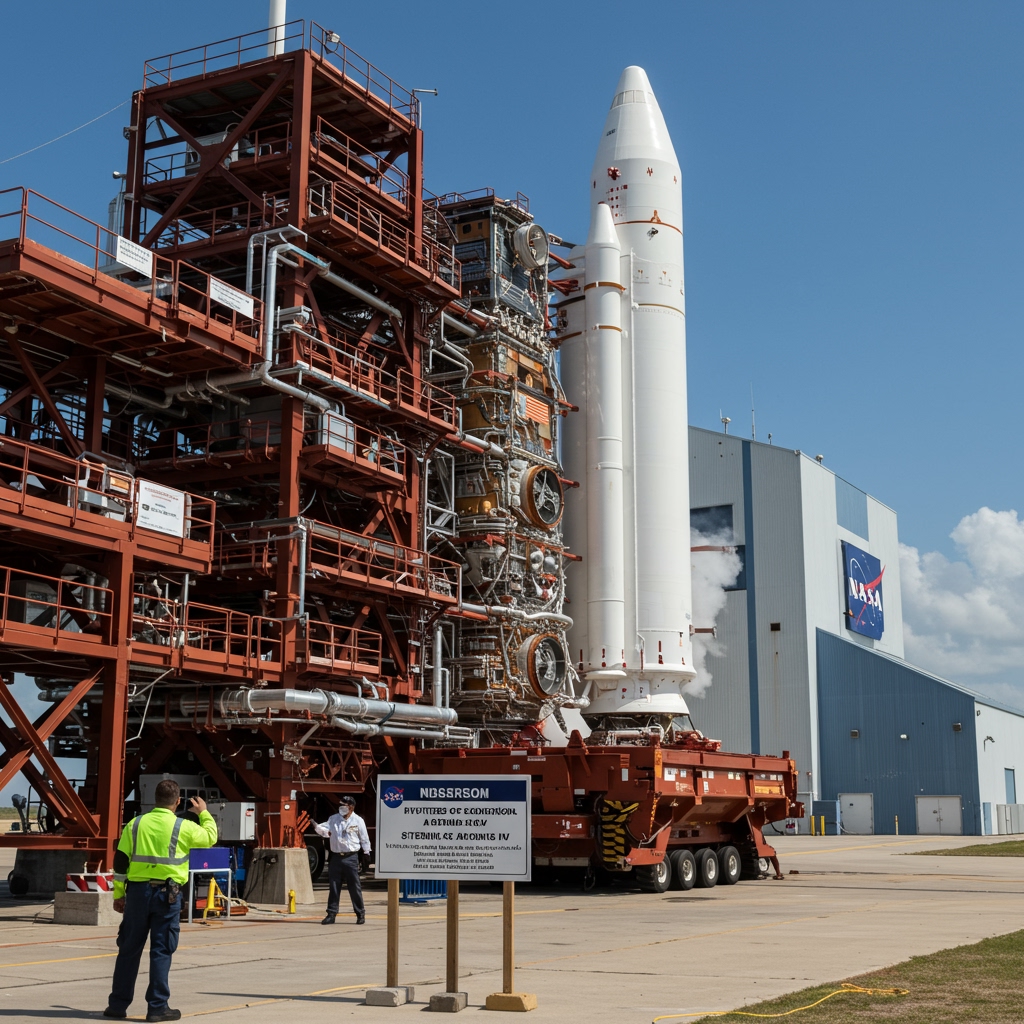NASA Initiates Critical Engine Tests for Artemis IV Mission
Following a period of successful system checks, engineers at NASA’s Stennis Space Center in Mississippi have commenced a pivotal phase of preparation for the Artemis IV mission. This crucial step involves initiating a critical series of Green Run engine tests on the Space Launch System (SLS) core stage specifically designated for the Artemis IV mission. These rigorous tests are designed to push the boundaries of the propulsion system, ensuring its readiness for future deep space voyages carrying astronauts.
Scheduled to unfold throughout late May 2025, this test campaign represents a significant milestone in the development and verification process for the powerful SLS rocket. The core stage, a marvel of modern engineering, is equipped with four formidable RS-25 engines. During these tests, these engines will be ignited and run through a sequence of operations that closely simulate the extreme conditions and performance requirements of an actual launch from Earth.
The Importance of the Green Run Campaign
The Green Run is a comprehensive test series that validates the integrated performance of the SLS core stage’s complex systems, culminating in the crucial hot-fire test of its engines. For the Artemis IV core stage, this series is designed not only to confirm basic functionality but to verify performance specifications required for the demanding trajectory and payload delivery of the upcoming mission. Simulating launch conditions allows engineers to collect invaluable data on how the engines and the core stage as a whole respond under maximum thrust, vibration, temperature, and pressure loads.
The four RS-25 engines, veterans of the Space Shuttle program and significantly upgraded for the SLS, are key to providing the immense power needed to escape Earth’s gravity and set the Orion spacecraft on its path to the Moon and beyond. Each engine must perform flawlessly and in perfect harmony with the others and the core stage’s intricate systems, including the propellant tanks, avionics, and thrust vector control.
Verifying Performance for Deep Space Voyages
The primary objective of these tests is to verify that the four RS-25 engines meet all required performance specifications. This includes thrust levels, operating parameters, and the ability to perform the complex ignition and shutdown sequences necessary for a successful launch. The data gathered during this series of Green Run engine tests is absolutely crucial. It provides engineers with definitive proof that the core stage and its engines are certified and ready to undertake the challenging task of launching the Artemis IV mission.
These tests are not merely procedural; they are a fundamental risk mitigation step. By rigorously testing the hardware on the ground, potential issues can be identified and addressed long before the vehicle is integrated for launch. This meticulous approach is essential for missions that will carry astronauts aboard the Orion spacecraft on deep space lunar voyages. The safety and success of these crewed missions depend directly on the verified performance and reliability of the SLS core stage and its engines.
Artemis IV: Advancing Lunar Exploration
The Artemis IV mission is a critical step in NASA’s broader Artemis program, which aims to establish a sustainable presence on the Moon. Following the uncrewed Artemis I and the crewed Artemis II and Artemis III missions, Artemis IV will play a vital role in building the infrastructure necessary for long-term lunar operations. A key objective of Artemis IV is to deliver essential components for the Gateway lunar outpost.
The Gateway is envisioned as a small space station orbiting the Moon, serving as a staging point for missions to the lunar surface and potentially future deep space exploration. Delivering these crucial components aboard the SLS rocket launched during Artemis IV is paramount to the construction and operational readiness of the Gateway. The successful completion of the Green Run engine tests at Stennis is therefore directly linked to the timeline and feasibility of this essential delivery.
Stennis Space Center: The Backbone of SLS Testing
NASA’s Stennis Space Center in Mississippi has a long and distinguished history as the nation’s premier large-scale rocket propulsion testing facility. Its unique infrastructure, including massive test stands capable of withstanding the tremendous forces generated by engines like the RS-25, makes it the ideal location for the SLS core stage Green Run tests. The highly skilled engineers and technicians at Stennis are experts in operating these complex test facilities and gathering the detailed data required to assess engine and stage performance.
The B-2 Test Stand at Stennis, where the core stage is mounted for these tests, is equipped with extensive instrumentation to monitor every aspect of the engines’ performance during firing. This includes thrust, pressure, temperature, fuel flow rates, and vibrational data. The data collected throughout late May 2025 will undergo intensive analysis by engineering teams to confirm the core stage’s readiness.
Maintaining the 2026 Launch Window
The successful and timely completion of this critical series of Green Run engine tests is essential for maintaining the planned 2026 launch window for Artemis IV. Any significant delays or unexpected issues identified during testing could impact the integration schedule and subsequent launch preparations. The rigorous test plan scheduled throughout late May 2025 is designed to acquire all necessary data efficiently while thoroughly evaluating the hardware.
NASA is committed to a methodical and safety-focused approach to the Artemis program. Verifying the performance of the SLS core stage and its RS-25 engines through comprehensive testing at Stennis is a non-negotiable step. The outcome of this test campaign will provide the confidence needed to proceed with the integration of the core stage with the other elements of the SLS rocket and the Orion spacecraft, keeping the Artemis IV mission on track for its vital role in expanding humanity’s presence in deep space and building the Gateway lunar outpost.





